Just to be clear, there is a big difference between “directional preference” (DP) and assuming a position that relieves your symptoms (accommodation positions)
DP is defined by any position or repeated movements that beneficially affects your symptoms and or mechanics during….
DP is defined by any position or repeated movements that beneficially affects your symptoms and or mechanics during….
And remains better afterwards. DP when present also has an affect on other movements and positions in a beneficial manner.
AP on the other hand is a position that gives symptom relief at the time, but rarely if ever improves the overall presentation and in some case…..
AP on the other hand is a position that gives symptom relief at the time, but rarely if ever improves the overall presentation and in some case…..
You may feel worse as a result of assuming this position afterwards. AP is a normal human instinct, we assume positions of less pain. This is similar to trapping a finger in a car door and opening the door for relief, but never removing the swelling finger. The door closes again
And the finger hurts worse than before.
DP actually slides the finger out of the door and allows the door to close without hitting the finger again.
DP has been shown in studies to be a sign fo good prognosis.
It is the hallmark of the McKenzie “derangement syndrome”
DP actually slides the finger out of the door and allows the door to close without hitting the finger again.
DP has been shown in studies to be a sign fo good prognosis.
It is the hallmark of the McKenzie “derangement syndrome”
AP is more suggestive of tissue trauma and an acute inflammatory reaction.
Both are acceptable self treatment strategies in the active presentation. One must beware when using AP that it is not making your condition worse afterwards.
Both are acceptable self treatment strategies in the active presentation. One must beware when using AP that it is not making your condition worse afterwards.
As usual, thanks for reading hope it was useful.
Update example
https://twitter.com/retlouping/status/1369446190698426370
Addition for context
https://twitter.com/retlouping/status/963590421086601216
Maybe we also need to unlabel symptom modification from the word “exercise”????
https://twitter.com/retlouping/status/1697514463690145813
Also important to remember that the McKenzie method of MDT is not just about symptom modification
https://twitter.com/retlouping/status/1004105034597060608
Also worth a read
https://twitter.com/retlouping/status/1003595456453242881
For anyone interested here is the clinical process I propose.
https://twitter.com/retlouping/status/1254132540736225280
A thought to ponder 👇
https://twitter.com/retlouping/status/1665451890585247746
• • •
Missing some Tweet in this thread? You can try to
force a refresh













